
Kashi Vishwanath Temple is a Hindu temple dedicated to Shiva. It is located in Vishwanath Gali, in Varanasi, Uttar Pradesh, India. The temple is a Hindu pilgrimage site and is one of the twelve Jyotirlinga shrines. The presiding deity is known by the names Vishwanath and Vishweshwara, literally meaning Lord of the Universe.
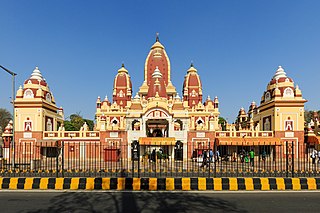
The Laxminarayan Mandir is a Hindu temple located in Delhi, India. The presiding deity in the temple is Laxminarayan i.e., Vishnu along with his consort Lakshmi. The temple was inaugurated by Mahatma Gandhi. Gandhi ensured that members of all castes would be allowed in the temple. It was built by Jugal Kishore Birla from 1933 and 1939. There are also small shrines on the sides dedicated to Shiva, Ganesha, Hanuman and Buddha.

The Birla Mandirs refer to different Hindu temples or Mandirs built by the Birla family in different cities across India. All these temples are magnificently built, some in white marble or sandstone. The temples are generally located in a prominent location, carefully designed to accommodate a large number of visitors. The worship and discourses are well organized. The first one was built in 1939 in Delhi collectively by Jugal Kishore Birla and his brothers and their father. Later temples were built by and managed by different branches of the family. For both of the temples in Varanasi, the Birlas joined other donors to support the cost.

Banaras State initially known as Banaras kingdom or Kashi Kingdom was a kingdom and later princely state under the Narayan Dynasty in what is today Uttar Pradesh, India. On 15 October 1948, Benares' last ruler signed the accession to the Indian Union.

The Vishalakshi Temple or Vishalakshi Gauri Temple is a Hindu temple dedicated to the goddess Vishalakshi, at Mir Ghat on the banks of the Ganges at Varanasi in Uttar Pradesh, India. It is generally regarded as a Shakti Pitha, the most sacred temples dedicated to the Hindu Divine Mother.
Chandra Mauli Upadhyay is an Indian astrologer and head of Jyotish department, Banaras Hindu University.

The Durga Mandir (Temple) is situated in Ramnagar of Banaras (or Varanasi). It is believed that it was built 500 years ago which is under control of royal family of Banaras State currently. This temple is devoted to Hindu deity Durga. The temple has a large stone built pond with it. The Durga Mandir boasts of its fine stone works, which is a fabulous example of north Indian stone work arts.

Situated in the northern part of India, bordering with the capital of India New Delhi, Uttar Pradesh is one of the most popular and an established tourist destination for both Indians and non-Indians alike in India. The most populous state of India, Uttar Pradesh contains many historical monuments and places of religious significance. Geographically, Uttar Pradesh is very diverse, with Himalayan foothills in the extreme north and the Gangetic Plain in the centre. It is also home of India's most visited sites, Hinduism's holiest city, Varanasi. Kumbh city, Prayagraj. Kathak, one of the eight forms of Indian classical dances, originated from Uttar Pradesh. Uttar Pradesh is at the heart of India, hence it is also known as The Heartland of India. Cuisine of Uttar Pradesh like Awadhi cuisine, Mughlai cuisine and Bhojpuri cuisine are very famous not only in India but also many places abroad.

The Gyanvapi Mosque is located in Varanasi, Uttar Pradesh, India. It was constructed by Aurangzeb c. 1678, a decade after his demolition of an old Shiva temple.
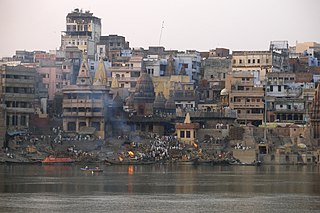
Varanasi is a city on the Ganges river in northern India that has a central place in the traditions of pilgrimage, death, and mourning in the Hindu world. The city has a syncretic tradition of Muslim artisanship that underpins its religious tourism. Located in the middle-Ganges valley in the southeastern part of the state of Uttar Pradesh, Varanasi lies on the left bank of the river. It is 692 kilometres (430 mi) to the southeast of India's capital New Delhi and 320 kilometres (200 mi) to the southeast of the state capital, Lucknow. It lies 121 kilometres (75 mi) downstream of Prayagraj, where the confluence with the Yamuna river is another major Hindu pilgrimage site.
Kashi Vishwanath Temple may refer to the following temples in India:

Bhelupur is a suburban neighbourhood located in south of Varanasi district. It is situated 2.5 kilometres west of Kedar ghat and to the river Ganges. Benaras Hindu University is situated 4.5 kilometres south of Bhelupur.
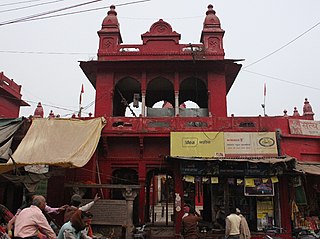
Durga Mandir, also known as Durga Kund Mandir and Durga Temple, is one of the most famous temples in the holy city of Varanasi. This temple has great religious importance in Hinduism and is dedicated to the Maa Durga. Durga Mandir was constructed in 18th century by Rani Bhabani of Natore.

Ravaneshwar Mandir is one of the most famous temples in the holy city of Varanasi. This temple has great historical and cultural importance in Hinduism.
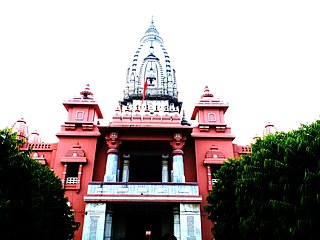
Shri Tilbhandeshwar Mahadev Mandir, also known as Tilbhandeshwar Mahadev Mandir and Tilbhandeshwar Mandir, is one of the oldest and most famous temples in the holy city of Varanasi. This temple has great religious importance in Hinduism and is dedicated to the Lord Shiva. Tilbhandeshwar Mandir is believed to be constructed in 18th century.
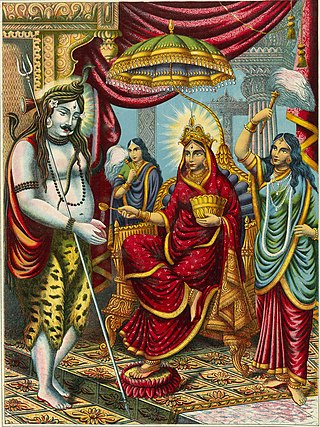
Annapurna Devi Mandir, also known as Annapurna Mata Mandir and Annapurna Mandir, is one of the most famous Hindu temples (Mandir) in the holy city of Varanasi. This temple has great religious importance in Hinduism and is dedicated to the goddess Annapurna. Annapurna is the Hindu goddess for nourishment and is a form of the goddess Parvati. The current Annapurna Mandir was constructed in the 18th century by Maratha Peshwa Bajirao I.
Lalita Gauri Mandir, also known as Lalita Mata Mandir, is one of the important and historic temples in the holy city of Varanasi. This temple has great religious importance in Hinduism and is dedicated to the goddess Lalita Gauri. The Mandir was constructed in early 19th century. The temple was constructed between 1800–1804 by Rana Bahadur Shah. Lalita Gauri Mandir is situated on the Lalita Ghat and the ghat was named after this temple.

Ratneshwar Mahadev Mandir is one of the most photographed temples in the holy city of Varanasi in Uttar Pradesh, India. The temple, while apparently well-preserved, leans significantly towards the back side (north-west), and its garbhagriha is generally below the water much of the year, except for a few months during the summer. The Ratneshwar Mahadev Temple is situated at Manikarnika Ghat, Varanasi. The temple has developed a nine-degree slant.
The Shri Kashi Karvat Mandir is a small suicide temple. It is a few meters away from the famous Blue Lassi shop of Kashi and Kashi Vishwanath Temple. It is said to be an ancient Shiva temple. It has a small temple which is visited only by the local people.

























